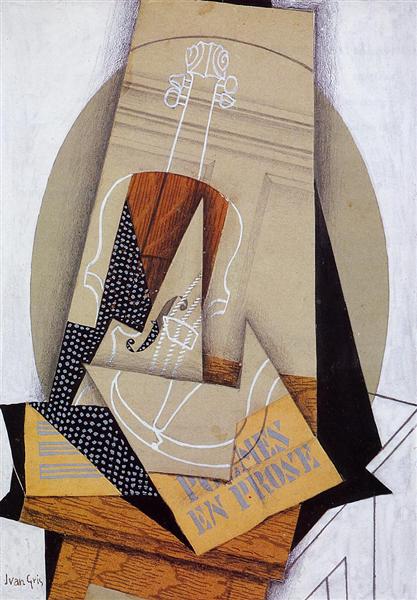Description
Juan Gris's 1914 Composition with Violin is a vibrant flash of Cubism, an artistic movement that the Spanish painter became one of the most prominent exponents of during the height of the movement. Juan Gris, whose real name was José Victoriano González Pérez, moved to Paris, where he became a key figure in the development of Cubism, in an environment where diverse talents such as Pablo Picasso and Georges Braque converged. Composition with Violin thus encapsulates an era rich in experimentation and the search for new forms of representation.
Upon observing the work, the viewer is greeted by an abstract structure of geometric shapes that provoke a sense of simultaneous decomposition and reconstruction. Gris employs a predominant palette of earth and ochre tones, which are intertwined with shades of blue and black, giving rise to a balanced and harmonious composition. These colours, in their simplicity, are deeply evocative, infusing the piece with an atmosphere of intimacy and sobriety. Light and shadow are masterfully manipulated, creating a dynamism that defies the two-dimensionality of the canvas; each shape seems to be revealed behind another, as if in a constant game of appearance and disappearance.
Unlike other Cubists who leaned toward pure abstraction, in Composition with Violin, Gris maintains referential elements from the real world. The violin, which occupies a central place, emerges from the juxtaposed forms and is presented both as an object in itself and as a symbol of the cultural and artistic wealth of the time. This duality in the representation of form and content is a hallmark of Gris's work, who knew how to combine Cubism with the tradition of figurative painting, maintaining a delicate balance between abstraction and allusion to reality.
Another fascinating aspect of “Composition with Violin” is its ability to invoke a narrative from fragmentation. On the canvas, not only the violin appears, but other elements such as a book and a sheet of paper are prominent, suggesting a musical and literary context. This connection between music and visual arts is a reflection of Gris’ own interest in synesthesia and how these disciplines can interact with each other. Each element is part of a cohesive whole that invites exploration of themes of artistic creation and subjective interpretation.
It is important to consider how this work fits into the context of Gris's production, who in those years was experimenting with a technique that combined strict geometry with lyrical subtlety. Throughout his career, Gris dealt with similar themes in other works, such as "Portrait of Pablo Picasso" or "Still Life with Guitar" where this constant revision of reality through the prism of cubism is perceived without losing the essence of the object represented.
"Composition with Violin" is not only a testimony to Juan Gris' creative maturity, but also a continuous dialogue with contemporary artistic movements and a decisive step towards the consolidation of Cubism. Each stroke and color in this work becomes an invitation to the viewer to immerse themselves in a world of visual complexity, where the simplicity of geometric forms contrasts with the depth of human aesthetic experience. Ultimately, Gris does not simply report a reality, he reinterprets it, and "Composition with Violin" stands as a magnificent example of the beauty that arises from simultaneity in Cubism.
KUADROS ©, a famous painting on your wall.
Hand-made oil painting reproductions, with the quality of professional artists and the distinctive seal of KUADROS ©.
Painting reproduction service with satisfaction guarantee. If you are not completely satisfied with the replica of your painting, we will refund 100% of your money.

